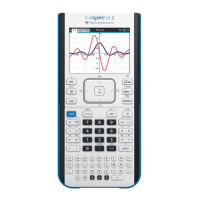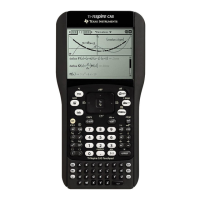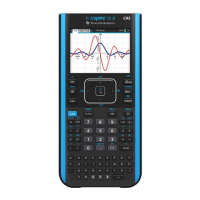86 TI-Nspire™ Reference Guide
If #ofRotations is positive, the rotation is to the left. If #ofRotations
is negative, the rotation is to the right. The default is L1 (rotate right
one bit).
For example, in a right rotation:
In Hex base mode:
Each bit rotates right.
0b00000000000001111010110000110101
Rightmost bit rotates to leftmost.
produces:
0b10000000000000111101011000011010
The result is displayed according to the Base mode.
Important: To enter a binary or hexadecimal number, always
use the 0b or 0h prefix (zero, not the letter O).
rotate(List1[,#ofRotations]) ⇒ list
Returns a copy of List1 rotated right or left by #of Rotations
elements. Does not alter List1.
If #ofRotations is positive, the rotation is to the left. If #of Rotations
is negative, the rotation is to the right. The default is L1 (rotate right
one element).
In Dec base mode:
rotate(String1[,#ofRotations]) ⇒ string
Returns a copy of String1 rotated right or left by #ofRotations
characters. Does not alter String1.
If #ofRotations is positive, the rotation is to the left. If #ofRotations
is negative, the rotation is to the right. The default is L1 (rotate right
one character).
round()
Catalog
>
round(Va lu e1 [, digits]) ⇒ value
Returns the argument rounded to the specified number of digits after
the decimal point.
digits must be an integer in the range 0–12. If digits is not included,
returns the argument rounded to 12 significant digits.
Note: Display digits mode may affect how this is displayed.
round(List1[, digits]) ⇒ list
Returns a list of the elements rounded to the specified number of
digits.
round(Matrix1[, digits]) ⇒ matrix
Returns a matrix of the elements rounded to the specified number of
digits.
rowAdd()
Catalog
>
rowAdd(Matrix1, rIndex1, rIndex2) ⇒ matrix
Returns a copy of Matrix1 with row rIndex2 replaced by the sum of
rows rIndex1 and rIndex2.
rotate()
Catalog
>

